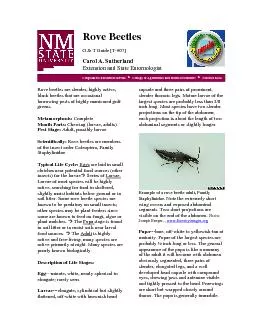

are occasional burrowing pests of highly manicured golf Metamorphosis Complete Chewing larvae adults Rove beetles are members of the insect order Coleoptera Family Staphylinidae are laid ID: 837640
Download Pdf The PPT/PDF document "Carol A Sutherland Extension and State E..." is the property of its rightful owner. Permission is granted to download and print the materials on this web site for personal, non-commercial use only, and to display it on your personal computer provided you do not modify the materials and that you retain all copyright notices contained in the materials. By downloading content from our website, you accept the terms of this agreement.
1 Carol A. Sutherland Extension and State
Carol A. Sutherland Extension and State Entomologist are occasional burrowing pests of highly manicured golf Metamorphosis: Complete Chewing (larvae, adults). Rove beetles are members of the insect order Coleoptera, Family Staphylinidae. are laid in small insects) for the larvae Series of Larvae. Larvae of most species will be highly slightly moist habitats below ground or in soil litter. Some rove beetle species are known to be predatory on small insects; other species may be plant feeders since some are known to feed on fungi, algae or plant mulches. in soil litter or in moist soils near larval active and free-living; many species are active primarily at night. Many species are Description of Life Stages: ---minute, white, nearly spherical to flattened, off-white with brownish head capsule and three pairs of prominent, Mature larvae of the projections on the tip of the abdomen; each projection is about the length of two abdominal segments or slightly longer. Example of a rove beetle adult, Family Staphylinidae. Note the extremely short wing covers and exposed abdominal segments. Two short projections are visible on the end of the abdomen. Photo: Joseph Berger, , www.forestryimages.org maturity. Pupae of the largest species are appearance of the pupa is like a mummy of the adult it will become with abdomen obviously segmented, three pairs of developed head capsule with compound eyes, chewing jaws and antennae visible thorax. The pupa is generally immobile. Cooperative Extension Service College of Agriculture and Home Economics October 2006 O & T Guide [T-#07] page Most species are slender and dull black or very dark brown, generally resem
2 bling earwigs but without the caudal lea
bling earwigs but without the caudal leaving most of the abdominal segments and visible from aboveprojections may be visithe end of the abdomen. Some species flex the abdomen upward as they run. Habitat and Hosts: Rove beetles are agile larvae are active during warm weather. They may overwinter as larvae, pupae, or Some species of rove beetles eat mites, beetle larvae, aphids, and small caterpillars both as adults and larvae. y attracted to dead animals and dead insects, where they other insects feeding there. While larval feeding habits of many rove beetle species are unknown, members of at least one subfamily are known to feed on fungi, algae and plant-based mulches; at least in the laboratory, many species, including predators, will feed to some extent on fruit slices. Cultural practices associated with turf maintenance on golf courses probably the nocturnal beetles tunnel in the extremely short turf on golf tees. Adults and possibly larvae burrow, making small holes and mounds of soil on the golf turf, America. While many are under-scavengers around dead animals or dead insects, others may be omnivorous or even plant feeders to some extent. Unfortunately, some species of rove their burrowing habits on extremely short and highly manicured turf. Rove beetles are not considered pests on home lawn turf or most recreational and ornamental turf. No insecticides are labeled specifically for managers to make spot treatments, as needed, with currentlyinsecticides having activity against various New Mexico State University is an equal opportunity/affirmative action employer and educator. NMSU and the U.S. Department of Agriculture cooperating. October 2006 Las Cruces, N